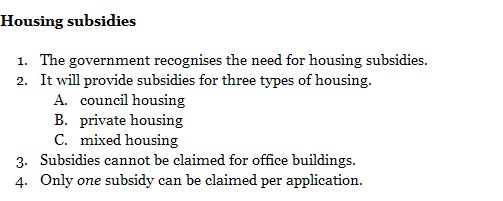tutorial, guidance notes, tips, and conventions
Numbered lists – definition
Numbered lists are used when it is important to draw attention to individual items in a group. They are also used to emphasise an ordered sequence.
Putting items in a numbered list helps a reader to see them both individually and as group. Both can be seen at the same time. Here’s an example:
Our main branch stocks –
- electrical goods
- household furniture
- domestic appliances
- leisure and sportswear
- fashion and accessories
You can see that the list reveals these different categories of goods more clearly than if the same information is presented in a sentence, with the items separated by commas.
Our main branch stocks electrical goods, household furniture, domestic appliances, leisure and sportswear, fashion and accessories.
Sequence in numbered lists
Numbered lists are especially useful if it is important that the items follow a particular sequence. Here’s an example from a recipe:
Basic scrambled eggs
- Melt two ounces of butter in a pan.
- Beat two fresh eggs in a bowl.
- Add one third of a cup of milk.
- Add a pinch of salt and pepper.
- Whisk until frothy.
- Pour mixture into pan.
- Stir continuously until semi-firm.
Parallelism in lists
Numbered and bulleted lists work best when each of the items listed is expressed in the same way. This is known as grammatical parallelism. In the example above, notice that each item begins with an action verb (Melt, Beat, Add) followed by the instruction.
In the next bad example, the items are expressed in a variety of grammatical forms. This blurrs the message being conveyed. In fact the items are also different in kind, because some are instructions, whilst others are information.
Fire regulations [BAD example]
- When the fire alarm goes off, you should leave the building.
- DON’T use the main stairway, as this could be dangerous.
- All fire exits are clearly marked.
- The main assembly point is located behind the warehouse.
Punctuation of lists
If the items in the list are expressed as complete sentences, they should be puctuated in the normal way. This means starting with a capital letter and ending with a full stop.
Health and safety regulations
- All doors must be locked by 6.00 pm.
- Smoking is not permitted in the building.
- All staff must be trained in the new fire regulations.
- No personal belongings may be left in the office overnight.
If the list items are sentence fragments, short phrases, or single words, there is no need to follow the normal rules of punctuation.
You will need five tools to complete this task:
- a screwdriver
- a hammer
- a spirit level
- a pair of pliers
- a measuring tape
Indentation of lists
It is common for numbered lists to be shown indented from the rest of the text – as they are on this page.
You can do this manually using the INDENT or TAB key on your keyboard. If you are using Microsoft Word, it will try to take over this process from you, indenting and numbering each sucessive line. This can be very annoying.
Nested lists
Sometimes it may be necessary to have a list within a list. This sometimes happens in lengthy and complex reports.
There are three key issues to be observed in cases of nested lists:
- The same general rules of presentation apply.
- Indetation is increased to include double indentation.
- The nested list needs a different system of numbering.
The secondary system of numbering should be easily distinguishable from the first. Use Roman numerals if necessary. If the numerical ordering is less important, it might be better to use an alphabetical system (a, b, c) or even revert to a bulleted list.

Numbering systems
The numbers shown in a list can be offered as Arabic numbers (3, 4, 5, 6) or as Roman numerals (VII, XII, IV — or — iii, iv, v, vi). Avoid using Roman numerals unless you have a pressing need to do so, because this gives the reader extra work in comprehension.
Most word-processors will have this numbering feature automated. In Microsoft Word for instance, look under Paragraph -> Numbering.
There is not much point in having a list of items which goes into double figures or beyond. Readers will not be able to remember the order of the items. An exception can be made if it is a document that will be printed and used as a reference guide.
© Roy Johnson 2012
More on How-To
More on literary studies
More on writing skills